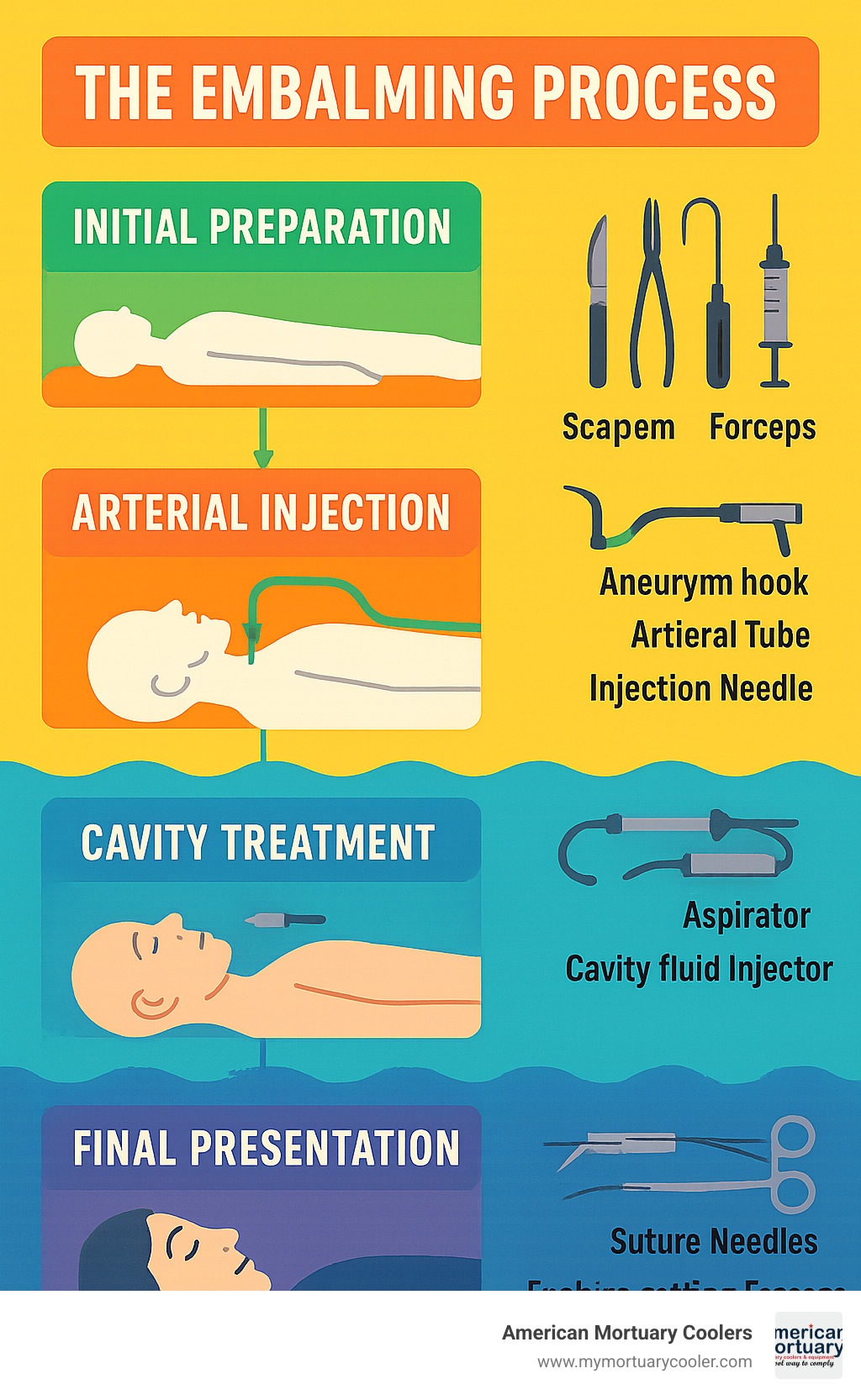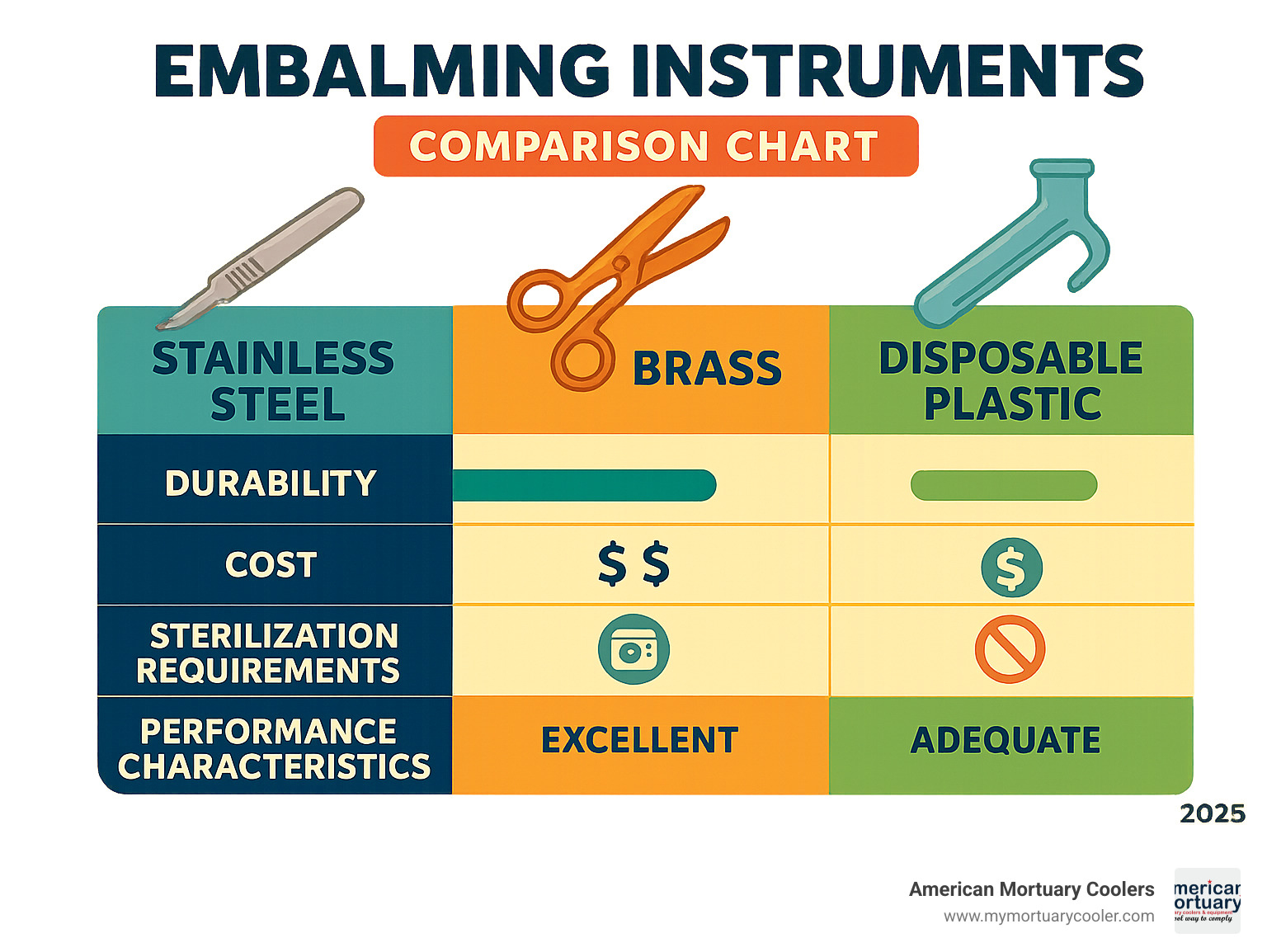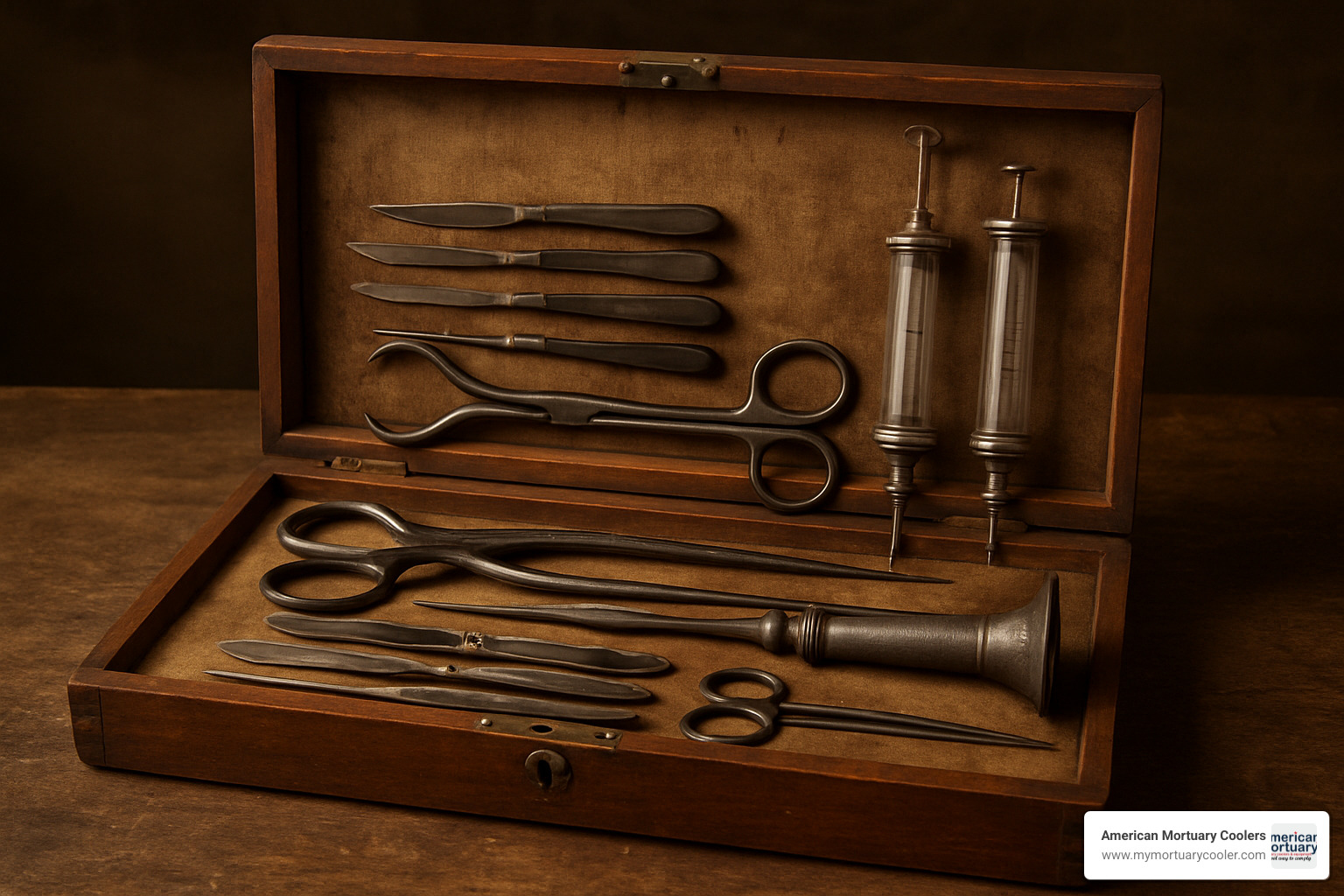Why Understanding Embalming Instruments Is Essential for Every Funeral Professional
Embalming-instruments- are the specialized tools that make professional body preservation possible, ranging from basic scalpels and forceps to advanced trocars and arterial injection systems. These precision instruments enable funeral directors to perform arterial embalming, cavity treatment, and restorative work that ensures dignified presentation for families during their most difficult moments.
Essential embalming instruments include:
- Arterial tools - Scalpels, aneurysm hooks, arterial tubes, and injection needles for vascular access
- Cavity instruments - Trocars, aspirators, and cavity fluid injectors for internal preservation
- Drainage equipment - Drain tubes, clamps, and collection systems for blood removal
- Restorative aids - Needle injectors, suture materials, and specialized forceps for feature setting
- Safety equipment - Protective gloves, instrument trays, and sterilization supplies
The global funeral supplies market is projected to reach $27.8 billion by 2027, with embalming instruments representing a critical component of every funeral home's operational capacity. A standard instrument kit contains 15-25 specialized tools, with individual prices ranging from $1.19 for basic needles to over $120 for hypodermic trocars.
We're American Mortuary Coolers, a Tennessee-based mortuary equipment supplier with extensive experience helping funeral directors select and maintain embalming-instruments- that meet their specific operational needs.

What Are Embalming-Instruments-? Categories, Materials & Key Functions
Embalming-instruments- are specialized tools designed for post-mortem care, where tissue conditions and procedural requirements differ significantly from surgical applications. These instruments help funeral directors replace blood with preservative chemicals while maintaining natural appearance.
What sets embalming tools apart is their design for post-mortem conditions. Dead tissue behaves differently, embalming fluids have different viscosities than blood, and there's no heartbeat to help with circulation. These factors require instruments with specialized angles, different pressure tolerances, and materials that handle formaldehyde-based chemicals.
Modern embalming-instruments- come in three main material families. Stainless steel remains the gold standard for reusable tools - it resists corrosion from harsh embalming chemicals, holds sharp edges through countless uses, and survives repeated sterilization cycles.
Chrome-plated brass fills a specialized niche, particularly for trocar points and injection fittings where complex shapes and precise threading matter. Medical-grade plastics have revolutionized single-use applications, eliminating cross-contamination worries while reducing cleaning time between cases.
Embalming-Instruments-: Main Types Overview
Every prep room needs eight essential categories of embalming-instruments-:
Forceps come in multiple varieties - serrated for gripping vessels, smooth for delicate tissue work, curved for accessing awkward angles. Scalpels provide sharp, precise cuts needed to access arteries and veins cleanly. Scissors handle both tough connective tissue and delicate vessel preparation.
Trocars are hollow instruments that make cavity treatment possible, piercing body cavities to remove gases and fluids, then inject preservative chemicals. Arterial tubes connect embalming machines to the body's circulatory system. Needle injectors set facial features for natural-looking mouth closure.
Aneurysm hooks isolate blood vessels during arterial preparation without damaging vessel walls. Drainage tubes complete the fluid circulation system by removing displaced blood during arterial injection.
Materials & Manufacturing Standards
Surgical stainless steel (316L grade) represents the premium choice for daily-use instruments. This material offers exceptional resistance to harsh embalming chemicals and maintains razor-sharp edges through repeated use.
Chrome-plated brass works well for components requiring complex shapes or precise threading, while medical-grade plastics excel in single-use applications where eliminating cross-contamination risks justifies ongoing replacement costs.

The manufacturing standards for quality embalming instruments emphasize corrosion resistance above all else. The acidic nature of many embalming chemicals creates an aggressive environment that quickly destroys inferior materials.
Step-by-Step Uses of Essential Embalming Instruments
Every successful embalming follows a sequence from vessel access to arterial injection, then cavity treatment and restorative work. Each step requires specific embalming-instruments- used at the right time.
Infection control remains critical throughout every step. Every instrument must be properly sterilized before use, and single-use items stay single-use.
Vessel Access & Injection
Getting clean access to blood vessels requires precision. Most embalmers work with the right carotid artery for injection while using the jugular vein for drainage.
Your scalpel makes the crucial first cut to expose vessels. A comprehensive guide to ten blade scalpel details covers proper blade selection, with the #10 blade being the go-to choice for clean incisions.
The aneurysm needle separates arteries from surrounding tissue, sliding under vessels and lifting them away without damage. Serrated forceps provide the grip needed to handle vessels safely. Our Serrated forceps 101 guide covers selection and technique.
Arterial tubes complete the connection between embalming machines and prepared arteries, maintaining consistent flow throughout the procedure.
Cavity Treatment With Trocars
Cavity treatment delivers preservatives directly inside body cavities and organs using specialized embalming-instruments-.
The closed-cavity method uses trocars to access internal organs efficiently. Trocar points come in different designs - sharp points for tough tissue, specialized points for specific organs. Trocar button applicators seal entry points to prevent leakage while maintaining natural appearance.
Hydro aspirators handle removal of liquids and semi-solid materials using water pressure to create suction. Cavity fluid injection follows aspiration, with trocars serving as both removal and injection tools.
Hypodermic & Specialized Techniques
Hypodermic instruments provide surgical precision for specific areas. Hypodermic trocars deliver exact amounts of preservative to targeted tissue areas. Tissue builder needles restore natural contours and eliminate sunken areas.
Scientific research on Civil War embalming pumps shows how far we've advanced. Thomas Holmes performed about 4,028 embalming procedures during the Civil War using primitive equipment compared to today's precision instruments.
Choosing the Right Embalming-Instruments- for Your Prep Room
Instrument kits eliminate guesswork, with basic starter kits beginning around $500 and comprehensive professional sets exceeding $2,000. The economy versus guaranteed grade decision depends on usage volume and reliability requirements.
Porti-Boy machine compatibility ensures everything works together smoothly. Vendor comparison reveals differences in quality, service, and support between major suppliers and regional distributors.
Maintenance, Sterilization & Safety Protocols
Proper care of embalming-instruments- protects you and ensures professional standards. Biohazard control forms the foundation of every safety protocol, as embalming procedures carry serious exposure risks.
Autoclave cycles provide reliable sterilization at 121°C (250°F) for 15-20 minutes, destroying all pathogens. Instrument trays keep tools organized and protect sterile instruments during storage.
Cleaning & Disinfection Workflow
Enzymatic soaking tackles protein-based contamination that accumulates during procedures. Ultrasonic baths reach places hands can't, with cavitation action penetrating every crevice in complex instruments.
Lysol I.C. at 1:256 dilution provides proven disinfection - one bottle creates 256 gallons of effective solution. Contact time matters: 4 minutes for HIV-1 and 10 minutes for other pathogens.
Drying racks prevent water spots and corrosion by ensuring complete moisture removal. All about embalming fluid: what you need to know covers chemical hazards affecting instrument care.
Personal & Environmental Safety
Cut-resistant gloves provide protection while maintaining dexterity. Eye protection prevents chemical splashes from reaching eyes. Ventilation systems remove chemical vapors from work environments.
Chemical Safety Data Sheets contain critical information about every prep room product. Spill response procedures address both chemical and biological contamination incidents.
Evolution, Brands & Costs: Antique vs Modern Instruments
The story of embalming-instruments- traces human ingenuity meeting necessity, evolving from crude battlefield preservation to precision medical artistry.

The 1860s Civil War Era marked organized embalming's beginning in America. Civil War pumps like George Tiemann's military embalming pump were mahogany-cased marvels measuring 18½ × 5½ × 3¼ inches. Scientific research on Civil War embalming pumps reveals early pioneer ingenuity.
The 1880s-1920s arsenic era used toxic formulas requiring specialized handling equipment. The 1930s-1950s formaldehyde era allowed safer handling and more effective preservation. Modern innovations from the 1960s onward brought digital pressure machines with real-time monitoring.
Price & Brand Snapshot
The Dodge Company leads with 130+ years of experience. Frigid Fluid Company specializes in chemicals and delivery instruments. Pierce Chemical Company built reputation on innovative solutions, while Clarke & Strong offers economy and guaranteed grade options.
Basic forceps range $5-$20 for economy grade, $25-$50 for premium models. Hypodermic trocars represent significant investment at $120+. Starter kits begin around $500, while comprehensive collections exceed $2,000.
Collectability & Historical Value
The collectible market reflects both historical significance and increasing rarity. Auction prices for Civil War-era kits command substantial prices from museums and collectors. Museum pieces preserve mortuary science history for education.
Buying Guide, Training & Troubleshooting Tips
National suppliers like The Dodge Company offer comprehensive catalogs and consistent service. Regional distributors provide personal relationships and local support. Online marketplaces offer competitive pricing but may lack technical support.
Required licensure varies by state, with most suppliers restricting professional-grade instruments to licensed funeral directors. An essential guide to Duotronic embalming machines explains compatibility factors.
Procurement & Supplier Checklist
Assess current instrument condition and create realistic replacement schedules. Consider case volume, operator skill levels, and budget constraints. Warranty coverage and replacement parts availability affect long-term value.
Training & Certification
State regulations set minimum standards for embalming education. Continuing education keeps practitioners current. Dodge seminars in Las Vegas offer comprehensive training on November 13-14, 2025, and November 12-13, 2026.
Troubleshooting Common Problems
Clogged trocars usually result from inadequate cleaning. Dull scalpels compromise precision - replace blades regularly. Seized clamps typically result from dried fluids - regular cleaning and light lubrication prevent problems. Leak prevention requires attention to connections and seals.
Frequently Asked Questions about Embalming Instruments
How long do stainless embalming tools last with proper care?
Quality stainless steel embalming-instruments- last decades with proper care. Surgical-grade stainless steel (316L grade) resists harsh embalming chemicals and maintains sharp edges through thousands of sterilization cycles. Many funeral directors use the same instruments for 20-30 years.
Material quality makes the biggest difference, while usage volume and maintenance practices directly impact longevity. Storage conditions also matter - dry, organized environments extend instrument life significantly.
Can disposable instruments fully replace reusable sets?
Disposable embalming-instruments- excel at infection control with zero cross-contamination risk and time savings. However, long-term costs add up quickly for high-volume operations, and quality reusable instruments offer better precision.
Most successful funeral homes use a hybrid approach - disposables for high-contamination procedures, quality reusable sets for precision work and cost control.
What's the safest way to transport sharp embalming implements?
Proper containers with rigid, puncture-resistant cases and secure closures protect both people and instruments. Individual slots or foam inserts prevent instruments from banging together. Never transport loose instruments - always secure everything properly.
Regulatory compliance includes OSHA requirements for workplace sharp instrument handling and potential DOT regulations for shipping.
Conclusion
Understanding embalming-instruments- transforms how funeral professionals approach their most important work - helping families honor loved ones with dignity. These specialized tools form the foundation of professional embalming practice.
Smart instrument selection requires understanding your specific needs. Material quality matters - surgical stainless steel lasts decades with proper care. Supplier reputation affects everything from product quality to ongoing support.
Training requirements can't be overlooked. State licensing and continuing education keep skills sharp as techniques evolve. The financial investment in quality embalming-instruments- pays for itself through improved efficiency.
Resources like The Complete Guide to the Embalming Process provide valuable insights for expanding knowledge.
Here at American Mortuary Coolers, we know successful funeral service requires comprehensive equipment solutions. Our custom mortuary coolers work alongside your embalming-instruments- to create prep rooms that support excellent work every day.
We deliver durable, custom-built solutions directly across all 48 contiguous states from our Tennessee headquarters. Whether upgrading aging equipment or building new facilities, we understand the unique challenges funeral directors face.
The right combination of quality instruments, proper training, and reliable equipment support creates the foundation for serving families during their most difficult moments. When everything works together seamlessly, you can focus on providing the compassionate, professional care that families need and deserve.


















